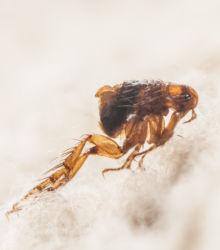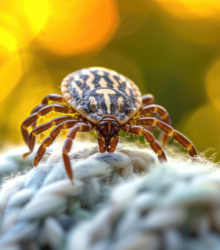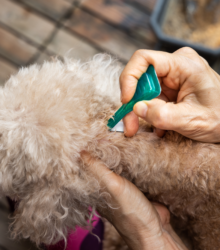Fleas and Ticks: Prevent Them from Bugging Your Dog (and You!)

We’ve been itching to tackle a subject that’s sure to have bugged you at some point: fleas and ticks. These tiny terrors turn our pets into scratch-happy maniacs! They can jump into our lives without any notice and catch us and our furry besties by surprise. While we often hear that fleas and ticks pop up seasonally, they can actually be a pesky year-round problem. They survive in various climates and can live inside your home and on your warm pet very comfortably.
Fleas can make your favorite Fido itch like crazy and cause serious skin problems, causing a lot of distress. Plus, for every flea you see, there could be hundreds of eggs and larvae hiding in your home (yikes & yuck!). Ticks are sneaky little things that are tough to get rid of and can cause Lyme disease and Rocky Mountain spotted fever, both of which are serious for our dogs. Learn more about these little buggers and how you can take some preemptive measures to stop them from invading your dog’s fur and home, and what actions you can take if they do make an appearance to keep you and your pet healthy.
 |
 |
| Flea | Tick |
Fleas vs. Ticks: Common Traits
Here’s a fun fact for your next trivia night: Ticks have 8 legs, making them arachnids (think spiders), while fleas are insects. A big shared trait – they both are extremely bothersome! Here’s some other common ones:
- They feed on your pet’s blood.
- They can transmit diseases.
- They use sharp mouthparts to cut into the skin and reach blood vessels, often leaving red, irritated spots behind.
- They can spread diseases to both humans and pets.
Flea Behavior
A flea is a wingless insect with incredible jumping abilities and lives happily in shaded, grassy areas. Adult fleas find one host, usually a dog or cat, and stay there until they die (their lifespan on a pet can last two to three months). Humans are not a flea’s first choice for a tasty bite, but they will as a last resort when they can’t find a more suitable host. They prefer infesting your dog’s fur and your house. They can multiply quickly, infesting your clothes and furniture.
Tick Behavior
Ticks typically wait around and latch onto their next victim as they walk by. They’re not picky and will attach to humans or pets for days, feeding on blood. Since ticks can’t fly or jump, they prefer living near their hosts, like in bird nests, rat burrows, or grassy and wooded areas. Ticks feed on rodents, rabbits, deer, and pets for up to two weeks at a time throughout their development stages and can live up to three years in various environments.

How Dogs Get Fleas and Ticks
Fleas:
- Other Animals: Direct contact with infested animals like other dogs, cats, or wildlife.
- Environment: Fleas thrive in grass, sand, and shaded areas, and dogs can pick them up during walks or while playing outside.
- Indoor Spaces: Fleas can hitch a ride into your home on your clothing or other pets and then infest your dog.
Ticks:
- Outdoors: Dogs can pick up ticks while exploring woods, tall grasses, your backyard, or the dog park.
- Other Animals: Ticks can transfer from other animals or pets.
Protective Steps
 Examining your dog is the easiest way to identify fleas or ticks. Use a flea comb to uncover adult fleas or flea dirt, especially around the rump and tail area. Flea dirt looks like brownish-black, granular dirt that turns red when placed on a wet paper towel. When looking for ticks run your hand along your dog’s body while pressing gently to feel for bumps. Ticks vary in size and can be as small as a pinhead or as big as a pencil eraser. Ticks prefer dark, hidden areas like the ears, armpits, groin, tail, and between the toes.
Examining your dog is the easiest way to identify fleas or ticks. Use a flea comb to uncover adult fleas or flea dirt, especially around the rump and tail area. Flea dirt looks like brownish-black, granular dirt that turns red when placed on a wet paper towel. When looking for ticks run your hand along your dog’s body while pressing gently to feel for bumps. Ticks vary in size and can be as small as a pinhead or as big as a pencil eraser. Ticks prefer dark, hidden areas like the ears, armpits, groin, tail, and between the toes.
Preventing Fleas:
- Regularly wash pet bedding, rugs, and any items pets frequently camp out on.
- Frequent brushing and bathing can help detect fleas early.
- Use vet-recommended flea-repelling products like topical treatments, oral medications, or flea collars.
- Vacuum daily to kill fleas that may have jumped onto floors.
- Keep your yard well-maintained, free of tall grass and debris.
Preventing Ticks:
|
 |
Health Risks from Fleas and Ticks
Fleas and ticks can spread infectious diseases when they bite and feed on pets or people.
Flea-Related Diseases:
- Flea Allergy Dermatitis (FAD): An allergic reaction to flea saliva causing intense itching and skin inflammation.
- Tapeworms: Fleas can carry tapeworm larvae, which dogs can ingest during grooming, leading to intestinal infections.
- Anemia: Severe infestations, especially in puppies, can cause significant blood loss and anemia.
Tick-Related Diseases:
- Lyme Disease: Caused by bacteria, leading to fever, lameness, and joint swelling.
- Rocky Mountain Spotted Fever (RMSF): Causes fever, rash, and muscle pain.
- Ehrlichiosis: Caused by bacteria, leading to fever, lethargy, and bleeding disorders.
- Anaplasmosis: Caused by bacteria, leading to joint pain, fever, and lethargy.
After a tick bite, if your dog shows symptoms like joint pain, limping, swollen lymph nodes, fever, lethargy, or decreased appetite, contact your vet immediately. Tick-borne illnesses can be extremely dangerous and even fatal.
Treating Fleas and Ticks
 Are Flea & Tick Medicines Safe? Flea and tick preventatives are generally effective for all types of dogs, but side effects are possible. Watch for signs of anxiousness, itchiness, vomiting, diarrhea, redness, and irritation.
Are Flea & Tick Medicines Safe? Flea and tick preventatives are generally effective for all types of dogs, but side effects are possible. Watch for signs of anxiousness, itchiness, vomiting, diarrhea, redness, and irritation.
How to Choose the Right One for Your Dog? It can be overwhelming with all the product choices. Options include over-the-counter or prescription treatments applied to the skin, worn as a collar, or given orally. Treatment plans vary from daily to monthly to several months. Your vet can help select an option based on your lifestyle, needs, and preferences for your dog.
Treatment Tips:
- Flea Treatment: Use a fast-acting treatment to kill adult fleas, followed by a long-term plan to break the life cycle.
- Tick Removal: Use fine-tipped tweezers to grasp the tick close to the skin and pull it out steadily. Clean the area with antiseptic and monitor for signs of infection or illness.
- Veterinary Care: Seek immediate veterinary care if your dog shows signs of illness after a flea or tick bite. Early treatment is crucial for diseases like Lyme disease and RMSF.

It’s amazing how these tiny pests can cause so much disruption. The good news is that with a little awareness and a plan, we can be prepared for when they hop into our lives. Taking quick steps to kick them out is the best way to keep your furry friend, home, and routine flea and tick-free.
Summer’s not quite over! Soak up that sun and get outside with your favorite four-legged travel pal, check out these tips to make your trip memorable, healthy and happy!
Are you taking a little getaway of your own? Happy Hound offers boarding with climate-controlled, comfortable sleeping areas, soft, clean bedding, and attentive staff to meet the needs of your pet pal. They can even spend some time running through our newest splash pad for some extra cool-down time! Learn More Here.